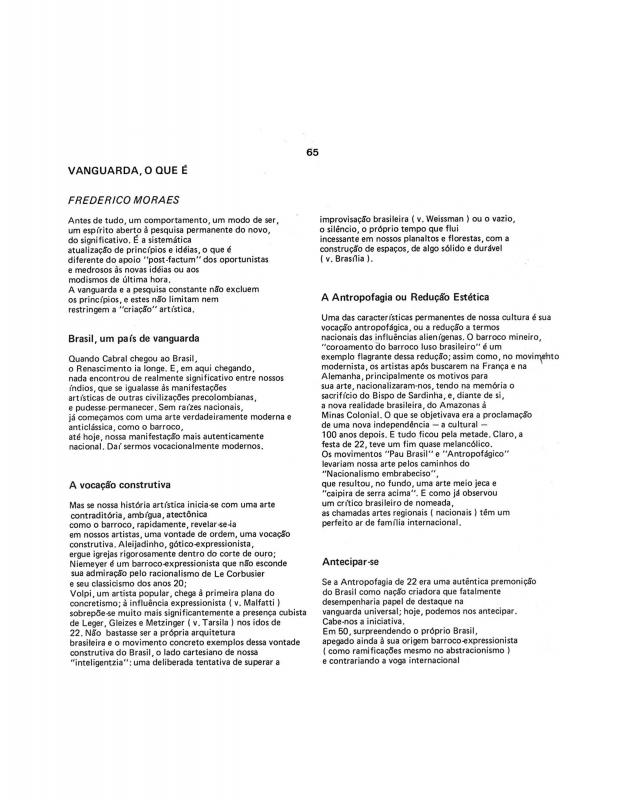The critic Frederico [de] Morais (b. 1936) was a regular contributor to Rio de Janeiro newspapers such as the Diário de Notícias and O Globo for many years. In addition to being an art curator and professor in Brazil during the 1960s and 1970s, Morais was quite a “committed” art critic; he threw his support behind several avant-garde movements during that period. As director of the MAM-RJ (Museu de Arte Moderna de Rio de Janeiro) from 1967 to 1973 he was responsible for class scheduling, and continued to give lectures at various universities, including the Faculdade de Arquitetura de la PUC-RJ. He has published thirty-six books on Brazilian and Latin American art, and has curated exhibitions in Brazil and elsewhere, including the retrospective Vanguarda Brasileira (Belo Horizonte, 1966) and the Bienal de Artes Visuais do Mercosul (Porto Alegre, 1989).
Morais takes an ironic approach in this essay as he attempts to define something that—whether because of the importance the movement enjoyed for a few decades or because of the constant animosity it elicited from other methods for making art—is elusive and hard to grasp. He refers to that matter at one point when he paraphrases the modernist painter Tarsila do Amaral (1886–1973), who was known to say that, for many artists in Brazil, Concrete art was a sort of mandatory military service. This essay appeared in Projeto Construtivo Brasileiro na Arte, the catalogue for the exhibition organized in São Paulo by Aracy Amaral (b. 1930) and Lygia Pape (1927–2004). The event was hugely influential in Brazil, prompting an innovative reading of the meaning of the rationalist movements in Brazilian art. The exhibition was presented in 1977 at the Pinacoteca do Estado de São Paulo and, later on, at the MAM-RJ (Museu de Arte Moderna do Rio de Janeiro).
[For more information about this exhibition, see the following in the ICAA Digital Archive: “Projeto construtivo brasileiro na arte” (doc. no. 1110680) by Pape; “A arquitetura é a grande arte de nosso tempo —1948: Romero Brest em São Paulo” (doc. no. 1314972) by
Jorge Romero Brest; “Arte Concreta” (doc. no. 1315020) and “Da arte concreta à arte neoconcreta” (doc. no. 1315036) by Ferreira Gullar); see also “O problema da educação artística depois da Bauhaus” (doc. no. 1315069) by Tomás Maldonado.]
[For other writings by Morais, see: “Escultura, objeto e participação” (doc. no. 1111085); “O desenho industrial e a realidade brasileira” (doc. no. 1110472); “Revisão do método crítico” (doc. no. 1110473); “Arte reprimida em São Paulo” (doc. no. 1110638); “Manifesto Do Corpo à Terra” (doc. no. 1110794); “Da crítica como produtora de teorias à socialização da atividade crítica” (doc. no. 777169); “Introdução: resistir ou libertar?” (doc. no. 1061858); “Contra a arte culta. A liderança dos ‘velhos’. O público de volta” (doc. no. 1110553); and “Vanguarda, o que é” (doc. no. 1110377), among many others.]












